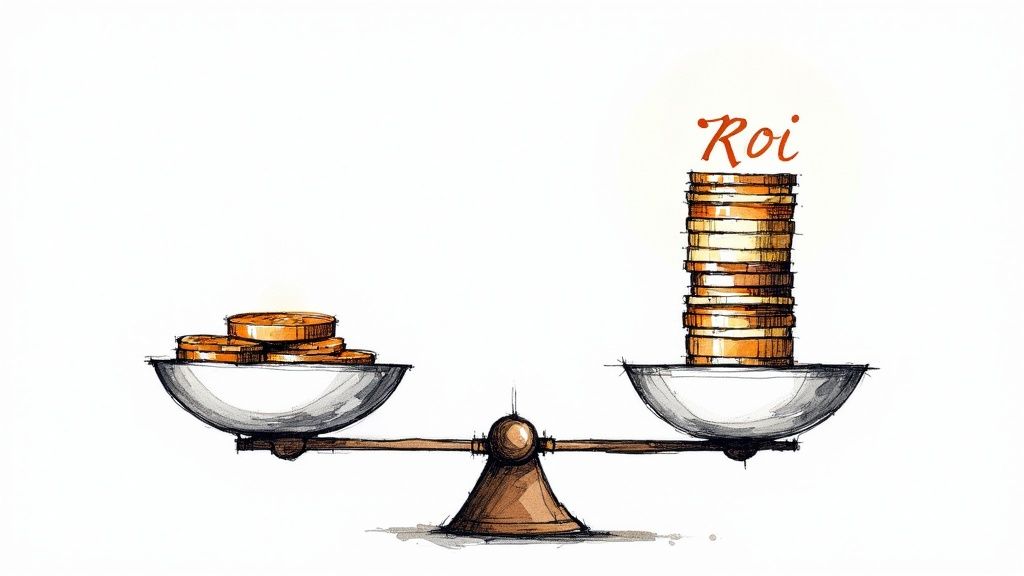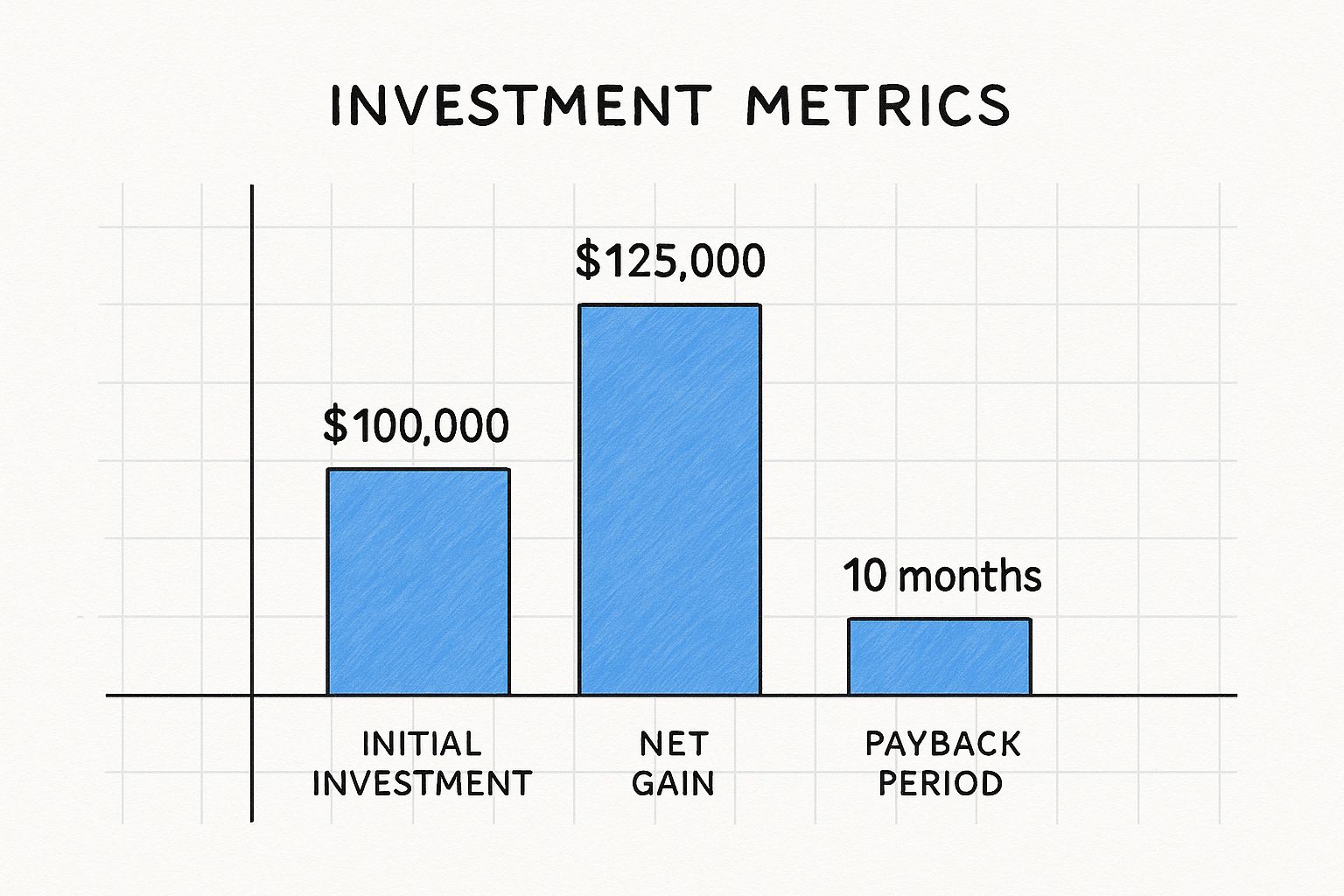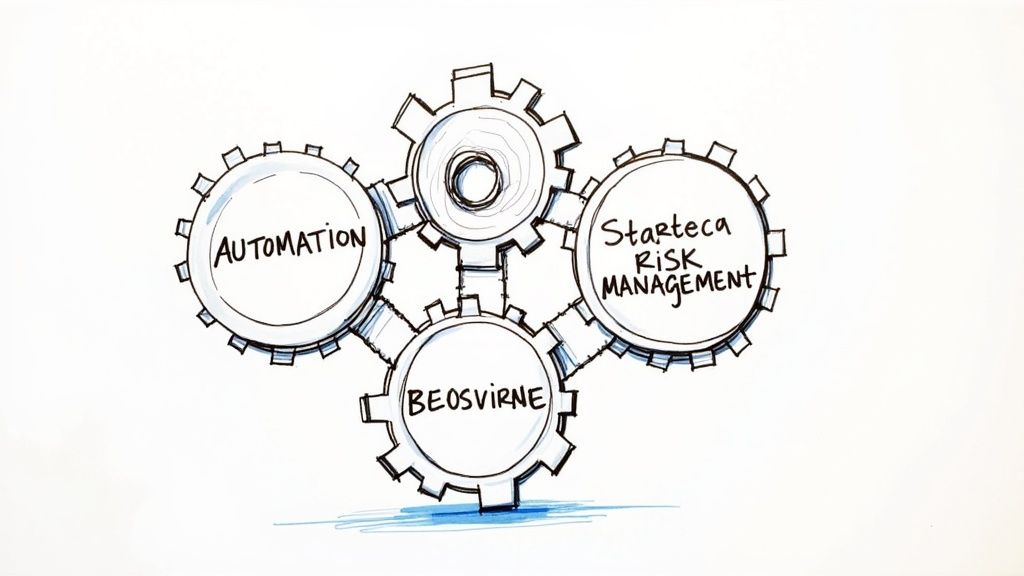
Boost Your Project Management ROI Today
Learn top strategies to improve project management ROI with data-driven methods and AI. Maximize your results and business impact now!

Demystifying Project Management ROI: What Actually Matters

Calculating project management ROI isn't as straightforward as evaluating a stock investment. It's more than just comparing money spent to money earned. It involves understanding how project management affects the entire organization. This means shifting focus from traditional inputs like budget adherence to the actual value created.
Moving Beyond Traditional Metrics
Historically, project success was measured by inputs: budget allocated, team size, and project duration. While important for planning and execution, these factors don't reveal the complete picture. They don't show the actual benefits for the organization. A project could finish on time and under budget yet fail to deliver the desired business outcomes. This shift in perspective is essential for accurately assessing project management ROI.
This is where value-driven measurement becomes important. Leading organizations are prioritizing outputs and outcomes. They ask: What tangible and intangible benefits were delivered? Was efficiency increased? Did customer satisfaction improve? Were new market opportunities created? These are the questions that executives care about.
Measuring Value in Project Management
Quantifying the ROI of project management offices (PMOs) can be challenging because the benefits they provide are often intangible. For instance, a PMO might establish standardized processes that enhance project delivery across the organization. This adds value, but it’s hard to express solely in financial terms. Likewise, improvements in team collaboration or risk mitigation are valuable but difficult to translate into monetary gains.
However, this doesn't mean measuring project management ROI is impossible. Advanced methodologies like Monte Carlo simulations, combined with project success and failure rates, offer more robust frameworks for calculating PMO ROI. This enables a more precise evaluation of project management's impact on the organization's bottom line. This research paper further explores these advanced methodologies and their use in quantifying the financial impact of project management.
Identifying Value Drivers
Identifying key value drivers within your organization is crucial for effective project management ROI measurement. These drivers will differ based on the industry, organizational structure, and project goals. A software company might prioritize speed to market, while a manufacturing company might focus on reducing production costs.
By clearly defining these value drivers, you can establish relevant baselines and track progress. This allows for a more focused and meaningful assessment of project management ROI, ensuring alignment with overall strategic objectives and contributing directly to organizational success. Focusing on these value drivers helps organizations demonstrate the real impact of effective project management.
Tool Investment That Pays Off: Beyond the Buzzwords

The infographic above illustrates how a strategic investment in project management tools can significantly impact your bottom line. It compares the initial investment with the resulting net gain and payback period. The data shows that with a $100,000 investment, a $125,000 net gain can be realized, leading to a payback period of only 10 months.
Choosing the right project management tools can dramatically improve your project management ROI. However, simply buying the most expensive software isn't the answer. Instead, organizations should prioritize tools that align with their specific needs and contribute to value creation. This strategic approach maximizes the return on investment and avoids the pitfalls of inadequate tools or overly complex platforms that go unused. The global project management software market is expected to reach $15.08 billion by 2030, demonstrating the growing awareness of ROI potential in project management. This market growth further emphasizes the importance of carefully selecting the right tools. Find more detailed statistics here.
Aligning Tools With Team Needs
One common pitfall is adopting complex, enterprise-level platforms when a simpler solution would be more effective. Smaller teams or those managing less complicated projects may find that a more streamlined, less expensive tool provides all the necessary features without unnecessary cost and complexity. This "right-sizing" approach to technology investments is key to achieving an optimal project management ROI. For instance, a team focused on task management and collaboration might benefit more from a lightweight Kanban board tool than a full-blown project portfolio management system.
Involving team members in the tool selection process is also critical. Understanding their workflows and challenges helps organizations choose tools that address specific needs and improve efficiency. This collaborative approach boosts user satisfaction and maximizes the tool's overall value, positively impacting project management ROI. Understanding ROI is crucial in other areas as well, such as security awareness training. You can learn more about this by reading about calculating the ROI of security awareness training.
Measuring the Impact
Measuring project management ROI from tool implementation involves focusing on concrete benefits. Improvements in collaboration can be tracked by measuring the reduction in meeting times or email volume. Gains in workflow efficiency can be measured by analyzing the decrease in cycle times for tasks or projects. Resource optimization, another key benefit, can be assessed by monitoring team member and equipment utilization rates.
To illustrate the value of project management software, let's look at some potential ROI metrics.
Project Management Software ROI Metrics
| Performance Metric | Before Implementation | After Implementation | Percentage Improvement |
|---|---|---|---|
| Project Completion Rate | 65% | 85% | 31% |
| Average Project Cycle Time | 60 days | 45 days | 25% |
| Resource Utilization | 70% | 85% | 21% |
| Time Spent on Administrative Tasks | 20 hours/week | 10 hours/week | 50% |
This table demonstrates how implementing project management software can lead to significant improvements across various key performance indicators. These metrics provide a tangible way to measure the software's impact and demonstrate a positive return on investment.
By tracking these and other metrics before and after implementing new tools, organizations can directly link their technology investments to measurable improvements. This data-driven approach provides clear evidence of the project management ROI achieved, justifying the initial expenditure and proving the tool's value to stakeholders. This emphasis on measurable outcomes is crucial for showcasing the real benefits of effective project management ROI.
AI-Powered Project Management: Beyond the Hype

Artificial intelligence (AI) is making waves in project management. It's not simply about automating mundane tasks. AI offers a way to fundamentally rethink how we predict risks, optimize resources, and deliver greater value. But separating the real impact from the marketing hype is crucial for effectively using AI.
Realizing the ROI of AI in Project Management
Early adopters of AI in project management are seeing substantial returns. Predictive analytics, powered by machine learning, is changing risk management. By examining past project data, AI can spot potential problems and recommend proactive solutions, reducing costly delays and disruptions. This data-driven approach allows project managers to anticipate challenges and address them head-on, resulting in better project outcomes and higher ROI.
AI-powered resource optimization algorithms are also cutting out costly inefficiencies. These algorithms assess team member skills, project requirements, and available resources to create the best work assignments. This ensures that the right people are on the right tasks at the right time, boosting productivity and reducing waste.
This smart allocation directly increases project efficiency and overall project management ROI. In fact, the integration of AI into project management has led to significant ROI improvements. A remarkable 90% of project managers using AI tools reported a positive ROI in the past year, proving the real-world benefits of this technology. Discover more insights about AI and project management ROI here.
Implementing AI for Measurable Returns
Successfully using AI for project management ROI needs a strategic plan. Organizations should focus on areas where AI can have the biggest impact. For example, automating administrative tasks like scheduling meetings or creating reports frees up team members for more important work, directly boosting project efficiency.
Integrating AI tools with existing project management software, like Asana, can also streamline workflows and improve data analysis. This creates a unified project management system, promoting collaboration and better decision-making. Choosing the right AI tools for your organization’s needs is key to maximizing project management ROI.
Overcoming Integration Challenges and Measuring Success
While the potential advantages are significant, integrating AI has its own challenges. Ensuring smooth integration with current systems and processes is crucial. Organizations must assess how well AI tools fit with their existing setup.
Measuring the specific ROI gains from AI requires a clear understanding of key performance indicators (KPIs). Tracking metrics like project completion rates, cycle times, and resource utilization provides valuable data for evaluating the impact of AI on project success and overall ROI.
To illustrate this further, let's look at the impact of different AI functionalities:
The following table outlines the ROI impact of various AI functionalities in project management:
AI Project Management Applications and Their ROI Impact
This table presents different AI functionalities in project management and their measured impact on key performance indicators.
| AI Functionality | Primary Benefit | Average ROI Impact | Implementation Complexity |
|---|---|---|---|
| Predictive Analytics | Reduced Risk & Delays | 15-25% | Medium |
| Resource Optimization | Improved Efficiency | 10-20% | Medium |
| Automated Reporting | Time Savings & Insights | 5-15% | Low |
| Intelligent Scheduling | Optimized Workflows | 5-10% | Low |
This table demonstrates how different AI applications can impact project ROI. While predictive analytics offers the highest potential ROI, it also has a higher implementation complexity. Automating simpler tasks like reporting and scheduling can provide quicker wins and build momentum for more complex AI integrations.
By addressing these integration challenges and defining clear KPIs, organizations can successfully leverage AI to improve their project management ROI and achieve tangible business results.
Metrics That Matter: Measuring What Executives Care About
Forget superficial metrics. This section explores measurement frameworks that truly resonate with executives and demonstrate the value of project management ROI. We'll discuss how to go beyond surface-level numbers and craft a compelling narrative of value creation.
Balancing Quantitative and Qualitative Measurement
Quantitative data, like cost savings, revenue growth, and productivity improvements, are essential for demonstrating ROI. However, numbers alone don't paint the whole picture.
Qualitative indicators, such as improved team morale, enhanced customer satisfaction, and a stronger brand reputation, also contribute significantly to project success.
Demonstrating project management ROI effectively requires a balanced approach. Incorporating both hard numbers and qualitative benefits offers a more comprehensive understanding of the true value generated by effective project management.
Establishing Credible Baselines
Measuring improvement requires a clear starting point. Establishing credible baselines is vital for tracking progress and showcasing the impact of project management initiatives.
This involves capturing the current state of key metrics before implementing any changes. Comparing pre- and post-implementation performance provides concrete evidence of improvement.
For example, to reduce project cycle times, first establish the average cycle time for similar past projects. This baseline serves as a benchmark for measuring future performance. You might be interested in exploring How to master Google Workspace project management for further insights into project management within the Google ecosystem.
Practical Tracking Systems
Implementing robust tracking doesn't have to be burdensome. Project management tools and software can automate data collection and reporting. Many platforms offer built-in features for tracking key metrics, including project timelines, budgets, and resource allocation.
This automation frees up time and resources, allowing project managers to focus on strategic activities. It also ensures data accuracy and consistency, crucial for credible reporting and informed decisions.
Contextualizing Results for Business Priorities
Finally, connect your results to broader business objectives. Explain how the achieved project management ROI directly contributes to the organization's strategic goals.
For instance, show how reduced project costs translate to increased profit margins or how improved product development cycle times lead to faster time to market.
By linking project outcomes to business value, you create a compelling narrative that resonates with executives. This approach showcases the value of completed projects and justifies future investment in project management initiatives. Demonstrating how project management fuels overall business success ensures buy-in and continued support from leadership.
Transforming Your PMO: From Cost Center to Value Driver

Is your Project Management Office (PMO) seen as more of a resource drain than a strategic powerhouse? Many organizations find it difficult to showcase the true value of their PMO. It's often perceived as bureaucratic overhead rather than a source of positive project management ROI. This can significantly limit the PMO's influence and its ability to contribute strategically. But some PMOs are thriving. They've successfully transitioned from simply enforcing processes to becoming true value catalysts that demonstrably improve the bottom line.
Reframing the PMO's Role: A Strategic Partner
The secret to transforming a PMO lies in rethinking its role within the organization. Instead of just enforcing processes, the PMO should act as a strategic partner, actively working towards achieving business objectives. This requires a shift away from administrative tasks and towards activities that directly create value.
For example, the PMO can play a vital role in portfolio management. It can help prioritize projects that are truly aligned with strategic goals and improve the way resources are allocated across the organization. This strategic focus can help the PMO become an integral part of achieving overall business success.
Establishing Enabling Governance
Traditional PMO governance can sometimes feel restrictive and may even hinder innovation. To avoid this, focus on establishing a governance structure that enables and empowers, rather than constrains. This means providing clear guidelines and frameworks that support project teams while still allowing for flexibility and adaptability.
Think of it like guardrails on a highway – they provide safety and direction without stopping forward momentum. This approach empowers project teams to deliver optimal results while maintaining necessary oversight. Read also: How to master small business project management for additional insights into streamlining project processes.
Quantifying the PMO's Contribution
Demonstrating the project management ROI of a PMO requires more than just anecdotal evidence. It demands quantifiable metrics. Develop clear methods for measuring the PMO's specific contributions to organizational success.
This might involve tracking improvements in project delivery times, reductions in project costs, or an increase in the overall success rate of projects. By directly linking PMO activities to tangible business outcomes, you build a powerful case for its continued value.
Communicating Value to Leadership
It's crucial to speak the language of executives. Communicate the PMO's value in terms that resonate with leadership. Focus on the strategic benefits and the positive financial impact.
Instead of highlighting process improvements, emphasize how the PMO contributes to broader business goals. These goals might include increased market share, faster time to market, or even improved customer satisfaction. This approach clearly demonstrates the PMO’s role as a vital contributor to the company's bottom line.
Balancing Standardization and Flexibility
While standardization is important for efficient project management, too much rigidity can stifle innovation. The most effective PMOs find the right balance between standardized processes and the flexibility teams need to adapt to changing circumstances.
This adaptability allows the organization to respond effectively to market shifts and embrace new opportunities, ultimately maximizing its project management ROI. This balanced approach acknowledges the unique nature of each project while still ensuring a consistent framework for successful execution. By fostering this balance, the PMO can drive both efficiency and innovation, contributing significantly to the organization's overall success.
Overcoming ROI Roadblocks: When The Numbers Don't Cooperate
Demonstrating a positive return on investment (ROI) for project management initiatives can be a real challenge. Even with meticulous planning, unexpected obstacles can pop up, making it tough to achieve the predicted results. These roadblocks can range from internal resistance to new processes to difficulties in accurately measuring the project management impact.
Navigating Change Resistance
One of the biggest hurdles to realizing project management ROI is overcoming resistance to change within the organization. People are often comfortable with existing workflows, even if they're inefficient. Introducing new project management methodologies or tools like Asana can be met with skepticism or even outright opposition. Addressing this resistance requires clear communication and showcasing the value of the proposed changes. This involves explaining how the new approach will benefit individual team members and the organization as a whole.
For example, demonstrating how a new tool will streamline tasks and reduce administrative overhead can help gain buy-in. Consider checking out resources like Why visual task management works for insights into improving workflow visualization.
Addressing Data Collection Challenges
Accurately measuring the impact of project management initiatives is crucial for demonstrating ROI. However, collecting the necessary data can be difficult. This can be due to a lack of established tracking mechanisms, inconsistent data entry practices, or the difficulty in quantifying intangible benefits like improved collaboration.
Overcoming these challenges requires implementing robust data collection processes and choosing the right metrics to track. This could involve utilizing project management software with built-in reporting features like Jira or creating custom dashboards to monitor key performance indicators.
To better understand the financial implications, you might want to explore the benefits of hiring a part-time CFO. For instance, learn how a Fractional CFO for Startups can contribute to financial optimization.
Maintaining Stakeholder Support
When results aren’t immediately apparent, maintaining stakeholder support can be tricky. Stakeholders often anticipate quick wins, and if the project management ROI isn't readily demonstrable, they may lose confidence in the initiative.
It's important to manage expectations from the start and communicate progress transparently. Regularly sharing updates, even if they don’t showcase dramatic improvements, demonstrates ongoing effort and commitment. Highlighting small wins and emphasizing the long-term project benefits can help maintain stakeholder confidence and secure continued support.
Isolating Project Management's Impact
Another challenge in demonstrating project management ROI is separating its contributions from other factors that influence business performance. Multiple initiatives often run concurrently, making it difficult to isolate the specific impact of project management improvements.
This requires careful analysis and a thorough understanding of the interplay between different business functions. Using control groups or conducting A/B testing can help isolate the effects of project management changes and provide more accurate ROI calculations.
Handling Attribution Problems
When multiple projects overlap, attribution becomes a significant hurdle. Determining which project contributed to which outcome can be complex, especially when initiatives share resources or objectives. This necessitates a structured approach to project planning and execution, with clear definitions of roles, responsibilities, and anticipated outcomes. Implementing a robust project portfolio management system can help track interdependencies and allocate contributions appropriately.
Building Credibility for ROI Claims
Finally, even with accurate data, demonstrating project management ROI in a skeptical environment can be challenging. Some stakeholders may question the data's validity or the methodology used to calculate ROI.
Building credibility requires transparency and rigor in the measurement process. Clearly documenting the data collection methods, assumptions, and calculations can help address stakeholder concerns and build confidence in the ROI claims. Presenting the data clearly and concisely, using visuals like charts and graphs, can also enhance understanding and persuade skeptical audiences.
Future-Proofing Your Project Management ROI Strategy
The project management field is constantly evolving. Is your approach to project management ROI keeping pace? This section explores emerging trends shaping how project value is created and measured, preparing your organization for the future of project management.
The Rise of Data and Predictive Analytics
Data analytics is essential for maximizing project management ROI. Tools like Tableau that capture real-time data on project progress, resource allocation, and budget consumption offer valuable insights for optimizing performance and demonstrating value.
Predictive modeling is also transforming the field. By using historical project data and machine learning, organizations can forecast potential risks, anticipate resource needs, and address potential roadblocks. This predictive capability is key to future-proofing your project management ROI strategy.
Continuous Value Delivery and Real-Time ROI Tracking
Traditional project management often measures ROI at a project's end. However, the future lies in continuous value delivery, prioritizing incremental value throughout the project lifecycle. This lets organizations realize returns sooner and adapt to changing requirements.
Continuous value delivery requires real-time ROI tracking. By constantly monitoring key performance indicators (KPIs) and linking them to business value, project managers can demonstrate ongoing progress and justify continued investment. Real-time tracking also enables early identification of issues affecting ROI, allowing for timely adjustments.
Integrated Platforms and Automation
Integrated platforms like Asana consolidate project data, communication, and reporting into a single ecosystem, streamlining workflows and reducing overhead. This facilitates collaboration, improves data visibility, and enables better decision-making, ultimately strengthening project management ROI.
Automation is also increasingly important. Automating repetitive tasks, such as scheduling, reporting, and resource allocation, frees project teams to focus on higher-value work that directly contributes to project success and boosts ROI.
Skill Development for the Future of Project Management
As technology evolves, so must project managers' skills. Future-proofing your project management ROI strategy involves investing in training and development. Equip your team with skills for a data-driven, AI-powered environment.
This includes proficiency in data analysis, predictive modeling, and using advanced project management tools. Soft skills like communication, collaboration, and adaptability are crucial for navigating complex modern projects and ensuring a positive return on investment.
Strategic Planning for Long-Term ROI
Maximizing project management ROI requires strategic thinking. Develop a long-term roadmap for your project management practices, incorporating emerging technologies, skill development, and a focus on continuous value delivery. This strategic framework keeps your approach aligned with evolving business needs and delivers sustainable returns.
Want to streamline your project management within Google Workspace and boost your team's efficiency? Check out Tooling Studio for powerful Chrome extensions designed to enhance your workflow and maximize your project management ROI.